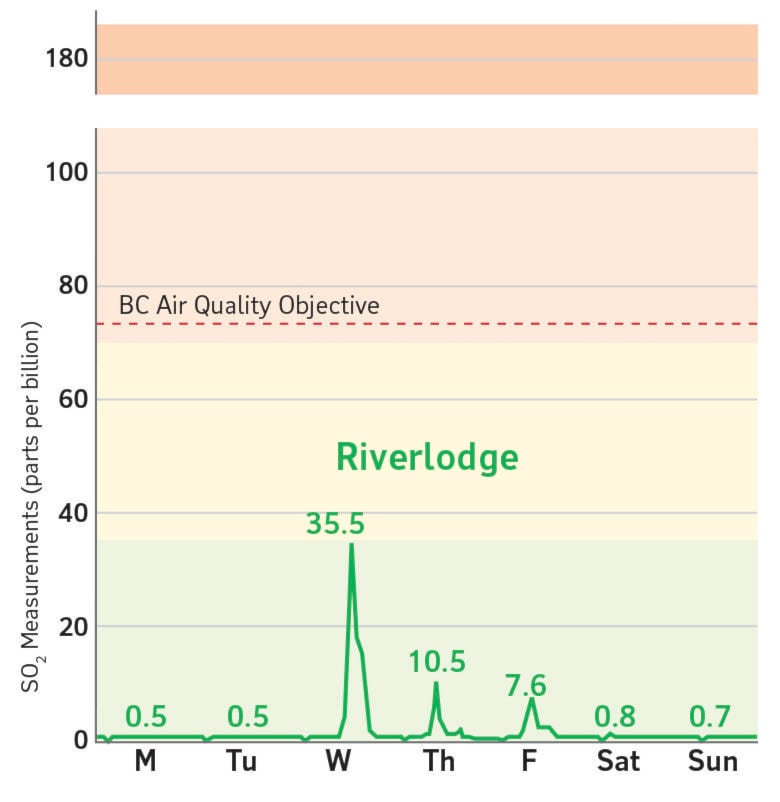A sulphur dioxide alert that was supposed to be sent by an automated monitoring system on October 3 was only sent to Kitimat residents a week later.
“There’s no way to mince words here – this was a failure of the system,” said Ralph Adams, a Kamloops-based air quality meteorologist for the Ministry of Environment and Climate Change Strategy.
Adams said an investigation revealed that a computer glitch was responsible for the alert for a 35.5 parts per billion sulphur dioxide (SO2) level in the air over Kitimat not going out.
“No-one got the alert on the third. The system is automated – it triggers by itself,” said Adams.
He said he and fellow air quality meteorologist Ben Weinstein check the air quality monitoring stations they are responsible for several times a day. Weinstein checked his station on the morning of October 4 and immediately noticed an alert level had been triggered.
“He didn’t get the alert and I remember him phoning me immediately and asking if I got it. And I didn’t. An investigation showed that the computer had triggered the alert correctly and it had sent the email to the server that is supposed to issue the actual text and voice messages. That one did not go out.”
He said ministry technicians hadn’t been able to determine why the second phase hadn’t been triggered. However, a week later before concluding their investigation the alert system righted itself and issued the advisory.
Adams said this is the first time staff had encountered this problem with the system – previous alert failures were false alarms caused by contractors calibrating the instruments without turning them off.
“The best really we can say at the moment is that this is a pilot project. We expect these kinds of problems to arise,” said Adams. “That’s really as much as we know at the moment.”
He said it was likely that the alert system would be migrated to a different set of servers in Victoria in the hope that that will address the problems.
He said the increase in the SO2 level that the system initially detected wasn’t particularly high.
“These spikes are fairly common – this was a fairly low-level one. It reached 35.5 parts per billion. At the moment we don’t have any evidence to indicate that this was due to some kind of upset or change at the Rio Tinto plant,” said Adams.
He explained that technically the system shouldn’t even have issued an alert as the level was below the threshold for a moderate trigger level.
A moderate trigger level ranges between 36 and 70 parts per billion, with high being between 71 and 185, and very high over 185 parts per billion SO2.
“The Canadian Air Quality Standard for one hour is 190, so the 35.5 parts per billion is relatively low compared to the objectives,” said Adams.
“Kitimat is in a remarkable location for pollution dispersion too because of the onshore wind. Even though there are periods of poor dispersion there are much less frequent than in the interior where we built all our communities and cities along rivers and railway lines at the bottom of the valley.”
In an air quality report distributed by Rio Tinto’s BC Works for the period from October 1 to October 5, all air quality monitoring measurements for the reporting period were considered “below provincial air quality objectives.”
The report confirmed that for a “maximum short term SO2 peak one-hour average”, the SO2 level was 35.5ppb at the Riverlodge monitoring station on Wednesday 3 October.
“Prevailing winds were typically blowing from the south and north during the reporting period and a transitional shift in wind direction on Wednesday 3 October caused a moderate peak in SO2. The cause for increased readings is weather dependent,” notes the report.
“The Riverlodge S02 monitoring station recorded a peak of 35.5 ppb on 3 October at approximately 6 p.m. local time.”
A Rio Tinto spokesperson said the S02 public alert system for Kitimat is managed by the BC Ministry of Environment.
“The system is entirely independent from Rio Tinto. We are unable to comment further, but encourage you to reach out to the ministry,” said the spokesperson in an email.
Adams added that while there is a “very high sensitivity to SO2 in the Kitimat area”, in a town like Trail, B.C., which registers far higher SO2 levels, there was “almost no concern whatsoever.”
He said the issue of SO2 levels is a complicated one, with two groups of people on either side of the argument, one group that believes all industrial emissions are bad and that there shouldn’t be any industry, while the other group believes emissions are irrelevant because industry is producing jobs.
“Most of the people are in the middle, but they rarely say anything, so it always sounds like two people hurling facts at each other. Someone has to find out what the difference is between the two arguments,” added Adams.
